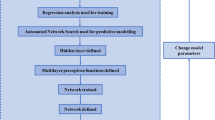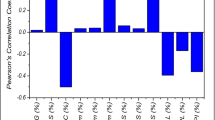Abstract
There have been studies analysing water retention and cracking in soil-biochar mix, but there is lack of model for estimating cracking in these kind of mixture. These models can be useful as it can be directly inputted in governing equations of seepage analysis for further analysing stability of green infrastructure. The objective of this study is to develop a model for computing crack as function of water content, suction and biochar content. Neural network-based modelling was adopted to achieve the objective. A series of experiments were conducted to quantify cracking in soil biochar composite using a novel crack intensity factor as a function of water retention and soil suction in five different soils with varying biochar content (i.e., 0%, 2%, 5%, 10% and 15%). The biochar was obtained from an invasive weed (i.e., Water hyacinth). The data obtained from the experimental study was then used for develo** model using Artificial neural networks (ANN) technique. A single ANN model was developed and validated with the testing data. The model was found to give satisfactory performance. This model can be useful in improving the water balance calculation in green infrastructure as well as agricultural fields (subjected to extreme drying-wetting season).








Similar content being viewed by others
References
Abel S, Peters A, Trinks S, Schonsky H, Facklam M, Wessolek G (2013) Impact of biochar and hydrochar addition on water retention and water repellency of sandy soil. Geoderma 202:183–191
Blanco-Canqui H (2017) Biochar and soil physical properties. Soil Sci Soc Am J 81:687–711
Bordoloi S, Yamsani SK, Garg A, Sreedeep S, Borah S (2015) Study on the efficacy of harmful weed species Eichhornia crassipes for soil reinforcement. Ecol Eng 85:218–222
Bordoloi S, Gadi VK, Hussain R, Sahoo L, Garg A, Sreedeep S, Mei G, Poulsen TG (2018a) Influence of fiber from waste weed Eichhornia crassipes on water retention and cracking characteristics of vegetated soils. Geotech Lett 8:1–25
Bordoloi S, Garg A, Sreedeep S, Lin P, Mei G (2018b) Investigation of cracking and water availability of soil-biochar composite synthesized from invasive weed water hyacinth. Bioresour Technol 263:665–677
Burrell LD, Zehetner F, Rampazzo N, Wimmer B, Soja G (2016) Long-term effects of biochar on soil physical properties. Geoderma 282:96–102
Chakraborty A, Goswami D (2017) Prediction of slope stability using multiple linear regression (MLR) and artificial neural network (ANN). Arab J Geosci 10(17):385
Das SK, Basudhar PK (2008) Prediction of residual friction angle of clays using artificial neural network. Eng Geol 100(3–4):142–145
Decagon devices (2016) MPS-2 & MPS-6 dielectric water potential sensors operator’s manual. Decagon Devices, Pullman
Engelbrecht AP (2007) Computational intelligence. Wiley, Chichester
Erzin Y, Ecemis N (2017) The use of neural networks for the prediction of cone penetration resistance of silty sands. Neural Comput Appl 28:727–736
Feddes RA, Kowalik PJ, Zaradny H (1978) Water uptake by plant roots. In: Simulation of field water use and crop yield, pp 16–30
Gamage DV, Mapa RB, Dharmakeerthi RS, Biswas A (2016) Effect of rice-husk biochar on selected soil properties in tropical alfisols. Soil Res 54:302–310
Gevrey M, Dimopoulos I, Lek S (2003) Review and comparison of methods to study the contribution of variables in artificial neural network models. Ecol Model 160:249–264
Ghaleini EN, Koopialipoor M, Momenzadeh M, Sarafraz ME, Mohamad ET, Gordan B (2019) A combination of artificial bee colony and neural network for approximating the safety factor of retaining walls. Eng Comput 35(2):647–658
Głąb T, Palmowska J, Zaleski T, Gondek K (2016) Effect of biochar application on soil hydrological properties and physical quality of sandy soil. Geoderma 281:11–20
Goh ATC, Kulhawy FH, Chua CG (2005) Bayesian neural network analysis of undrained side resistance of drilled shafts. J Geotech Geoenviron Eng 131(1):84–93
Hagan MT, Demuth HB, Beale MH (1996) Neural network design. PWS, Boston (MA)
Hornik K (1997) Multilayer feed-forward networks are universal approximators. Neural Net 2:359–366
Howell TA (2001) Enhancing water use efficiency in irrigated agriculture. Agron J 93:281–289
Jain AK, Mao J, Mohiddin KM (1996) Artificial neural networks: a tutorial. IEEE Comput 29:31–44
Kanungo DP, Arora MK, Sarkar S, Gupta RP (2006) A comparative study of conventional, artificial neutral network black box, fuzzy and combined neural and fuzzy weighting procedure for landslide susceptibility zonation in Darjeeling Himalayas. Eng Geol 85:347–366
Kanungo DP, Sharma S, Pain A (2014) Artificial neural network and regression tree (CART) applications for the indirect estimation of unsaturated soil shear strength parameters. Front Earth Sci 8:439–456
Karer J, Wimmer B, Zehetner F, Kloss S, Soja G (2013) Biochar application to temperate soils: effects on nutrient uptake and crop yield under field conditions. Agric Food Sci 22:390–403
Kuoppamäki K, Lehvävirta S (2016) Mitigating nutrient leaching from green roofs with biochar. Landsc Urban Plan 152:39–48
Lee S, Ryu JH, Won JS, Park HJ (2004) Determination and application of the weights for landslide susceptibility map** using an artificial neural network. Eng Geol 71:289–302
Lehman J, Joseph S (2015) Biochar for environmental management: science, technology and implementation. Cotnwall, Padstow, p 928
Li JH, Zhang LM (2010) Geometric parameters and representative elementary volume (REV) of a crack network in soil. Comput Geotech 37:466–475
Li JH, Zhang LM (2011) Study of desiccation crack initiation and development at ground surface. Eng Geol 123:347–358
Li JH, Zhang LM, Wang Y, Fredlund DG (2009) Permeability tensor and representative elementary volume of saturated cracked soil. Can Geotech J 46:928–942
Li JH, Li L, Chen R, Li DQ (2016) Cracking and vertical preferential flow through landfill clay liners. Eng Geol 206:33–41
Lim TJ, Spokas KA, Feyereisen G, Novak JM (2016) Predicting the impact of biochar additions on soil hydraulic properties. Chemosphere 142:136–144
Lu SG, Sun FF, Zong YT (2014) Effect of rice husk biochar and coal fly ash on some physical properties of expansive clayey soil (vertisol). CATENA 114:37–44
Maran JP, Sivakumar V, Thirugnanasambandham K, Sridhar R (2013) Artificial neural network and response surface methodology modeling in mass transfer parameters predictions during osmotic dehydration of Carica papaya L. Alex Eng J. 52:507–516
Olden JD, Joy MK, Death RG (2004) An accurate comparison of methods for quantifying variable importance in artificial neural networks using simulated data. Ecol Model 178:389–397
Paetsch L, Mueller CW, Kögel-Knabner I, Lützow M, Girardin C, Rumpel C (2018) Effect of in situ aged and fresh biochar on soil hydraulic conditions and microbial use under drought conditions. Sci Rep 8:6852
Peake LR, Reid BJ, Tang X (2014) Quantifying the influence of biochar on the physical and hydrological properties of dissimilar soils. Geoderma 235:182–190
Pratiwi EPA, Shinogi Y (2016) Rice husk biochar application to paddy soil and its effects on soil physical properties, plant growth, and methane emission. Paddy Water Environ 14:521–532
Qian WH, Shan XL, Zhu YF (2011) Ranking regional drought events in China for 1960–2009. Adv Atmos Sci 28(2):310–321
Rafiai H, Jafari A (2011) Artificial neural networks as a basis for new generation of rock failure criteria. Int J Rock Mech Min Sci 48:1153–1159
Rukhiayar S, Samadhiya NK (2017) A polyaxial strength model for intact sandstone based on artificial neural network. Int J Rock Mech Min Sci 95:26–47
Schalkoff RJ (1997) Artificial neural network. McGraw Hill, New York
Shahin MA, Maier HR, Jaksa MB (2002) Predicting settlement of shallow foundations using neural networks. J Geotech Geoenviron Eng 128:785–793
Shin H, Santamarina JC (2011) Desiccation cracks in saturated fine-grained soils: particle-level phenomena and effective-stress analysis. Géotechnique 61:961–972
Sonmez H, Gokceoglua C, Kayabas A, Nefeslioglu HA (2006) Estimation of rock modulus: for intact rocks with an artificial neural network and for rock masses with a new empirical equation. Int J Rock Mech Min Sci 43:224–235
Wallace R, Su C, Sun W (2017) Evaluation of biochar to enhance green infrastructure for removal of heavy metals in storm water. In: Proceedings of the 10th Oklahoma University international water conference, Norman, US
Ward PR, Flower KC, Cordingley N, Weeks C, Micin SF (2012) Soil water balance with cover crops and conservation agriculture in a mediterranean climate. Field Crops Res 132:33–39
Wong JTF, Chen Z, Chen X, Ng CWW, Wong MH (2017) Soil–water retention behavior of compacted biochar-amended clay: a novel landfill final cover material. J Soils Sediments 17:590–598
**e T, Reddy KR, Wang C, Yargicoglu E, Spokas K (2015) Characteristics and applications of biochar for environmental remediation: a review. Crit Rev Environ Sci Technol 45:939–969
Yesiller N, Miller CJ, Inci G, Yaldo K (2000) Desiccation and cracking behavior of three compacted landfill liner soils. Eng Geol 57:105–121
Yesilnacar E, Topal T (2005) Landslide susceptibility map**: a comparison of logistic regression and neural networks methods in a medium scale study, Hendek region, Turkey. Eng Geol 79:251–266
Zheng R, Chen Z, Cai C, Tie B, Liu X, Reid BJ, Huang Q, Lei M, Sun G, Baltrėnaitė E (2015) Mitigating heavy metal accumulation into rice (Oryza sativa L.) using biochar amendment-a field experiment in Hunan, china. Environ Sci Pollut Res 22:11097–11108
Acknowledgements
This work had been supported by the National Natural Science Foundation of China (Grant No. 51578164, 41672296 and 51878185), the Innovative Research Team Program of Guangxi Natural Science Foundation (Grant No. 2016GXNSFGA380008), the Changjiang Scholars Program of the Ministry of Education of China (Grant No. T2014273), the Bagui Scholars Program (Grant No. 2016A31) and the China Scholarship Council (CSC) (Grant No. 201906660001).
Author information
Authors and Affiliations
Corresponding author
Ethics declarations
Conflict of interest
This is to state that there is no conflict of interest with any third party from this study.
Additional information
Publisher's Note
Springer Nature remains neutral with regard to jurisdictional claims in published maps and institutional affiliations.
Rights and permissions
About this article
Cite this article
Rukhaiyar, S., Huang, S., Song, H. et al. A New Intelligent Model for Computing Crack in Compacted Soil-Biochar Mix: Application in Green Infrastructure. Geotech Geol Eng 38, 201–214 (2020). https://doi.org/10.1007/s10706-019-01009-6
Received:
Accepted:
Published:
Issue Date:
DOI: https://doi.org/10.1007/s10706-019-01009-6




